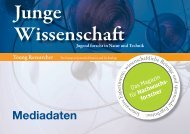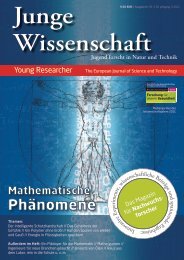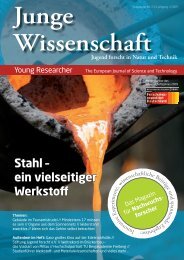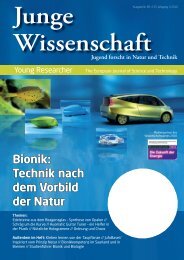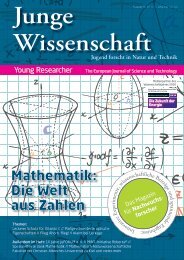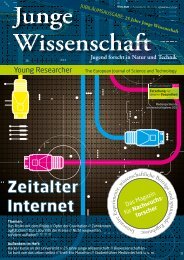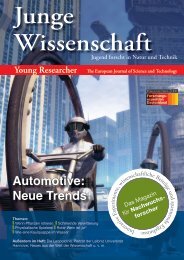2008: Das Jahr der Mathematik - Junge Wissenschaft
2008: Das Jahr der Mathematik - Junge Wissenschaft
2008: Das Jahr der Mathematik - Junge Wissenschaft
You also want an ePaper? Increase the reach of your titles
YUMPU automatically turns print PDFs into web optimized ePapers that Google loves.
Jugend forscht<br />
Jugend forscht<br />
For every stimulus four block types were created<br />
presenting only one kind of stimuli (with<br />
the needed modifications in the needed or<strong>der</strong><br />
according to the block type) in it. In the first<br />
block (type 1) adaptation was acquired by<br />
exposing the subject to the same image eight<br />
times. The second block (type 2) was composed<br />
of images with only minor changes. The<br />
third one (type 3) contained pictures with<br />
different aspects of modifications; original (nonmodified),<br />
spatial frequency modifications,<br />
contrast modifications and with modifications<br />
both in contrast level and in spatial frequency.<br />
The purpose behind this approach was that<br />
these changes interrupted the adaptation so we<br />
could use the fourth block (type 4) (which was<br />
quite similar to the second one concerning the<br />
types and numbers of different events) as a control.<br />
As the most important point was to have<br />
the first two and second two blocks to follow<br />
each other, we shuffled the blocks a bit so that<br />
our subject will not get bored and find any rules<br />
about the procedure of the experiment.<br />
Figure 2: Experiment B: Bottom row-original images, upper row-different modifications a) no modifications<br />
(presenting the same image again), b) face properties modification c) contrast modification d) a combined modification<br />
of both contrast and face-properties.<br />
short-term adaptation in high or<strong>der</strong> visual areas,<br />
we chose stimuli which most activate high<br />
or<strong>der</strong> visual cortex (Experiment B). As social<br />
primates, faces are the most common stimuli<br />
which we are exposed to in our life span.<br />
These kinds of stimuli are proved to activate<br />
mainly secondary areas in visual cortex. We<br />
decided to use unfamiliar faces to avoid any<br />
other effect. Four different images were used;<br />
each had four different types of modification<br />
(Fig. 2): the original image, a modified face,<br />
both with original and different level of contrast.<br />
Face modification was performed using<br />
‘Morphases’ program (www.morphases.com).<br />
All modified parameters were controlled such<br />
that in each image the modification level is<br />
comparable to the other.<br />
2.4 Presentation<br />
The experiments were conducted using ‘Presentation<br />
© ' program package.<br />
2.5 Procedure<br />
We were interested in the viewer's performances<br />
both in accuracy and speed aspects.<br />
Since there is a trade-off between the two, our<br />
instructions were to pay attention to both of<br />
them but accuracy should be more important<br />
than speed. Eight images were presented in a<br />
pseudo-random block sequence. Image presentation<br />
within each block was controlled in<br />
a way that preserves a constant ratio between<br />
different "events" (Fig. 3).<br />
Subjects were asked to perform ‘one-backmatch’<br />
task. The question to answer was to decide<br />
whether they consi<strong>der</strong> the presented image<br />
the same (pressing button ‘yes’), or they note<br />
any changes in the picture’s figural properties<br />
comparing to the previously presented image<br />
(pressing button ‘no’). We directed them to<br />
consi<strong>der</strong> only figural modification as remarkable<br />
change. As subjects were not informed<br />
about the aims of the block types, they were<br />
instructed to perform the task during the whole<br />
experiment.<br />
A fixation point was shown during the whole<br />
experiment. Visual epochs were alternated with<br />
5-s blanks. Four cycles of the stimulus were<br />
shown (one for each image). As we had altogether<br />
16 blocks the total time was 336s.<br />
3 Results<br />
Data analyses included several different aspects;<br />
all refer to the accuracy of performances regardless<br />
of subjects' response time.<br />
Figure 3: Experimental paradigm for experiment A (left) and B (right): (A) Four types of blocks (left to right): adaptation, control_1, adaptation interruption, control_2. (B) A segment from<br />
the time axis of the experimental run of an overall duration of 336s.<br />
34<br />
<strong>Junge</strong> <strong>Wissenschaft</strong> 79 // 1/<strong>2008</strong> // Short-term Adaption of Primary and High-or<strong>der</strong> Visual Areas



